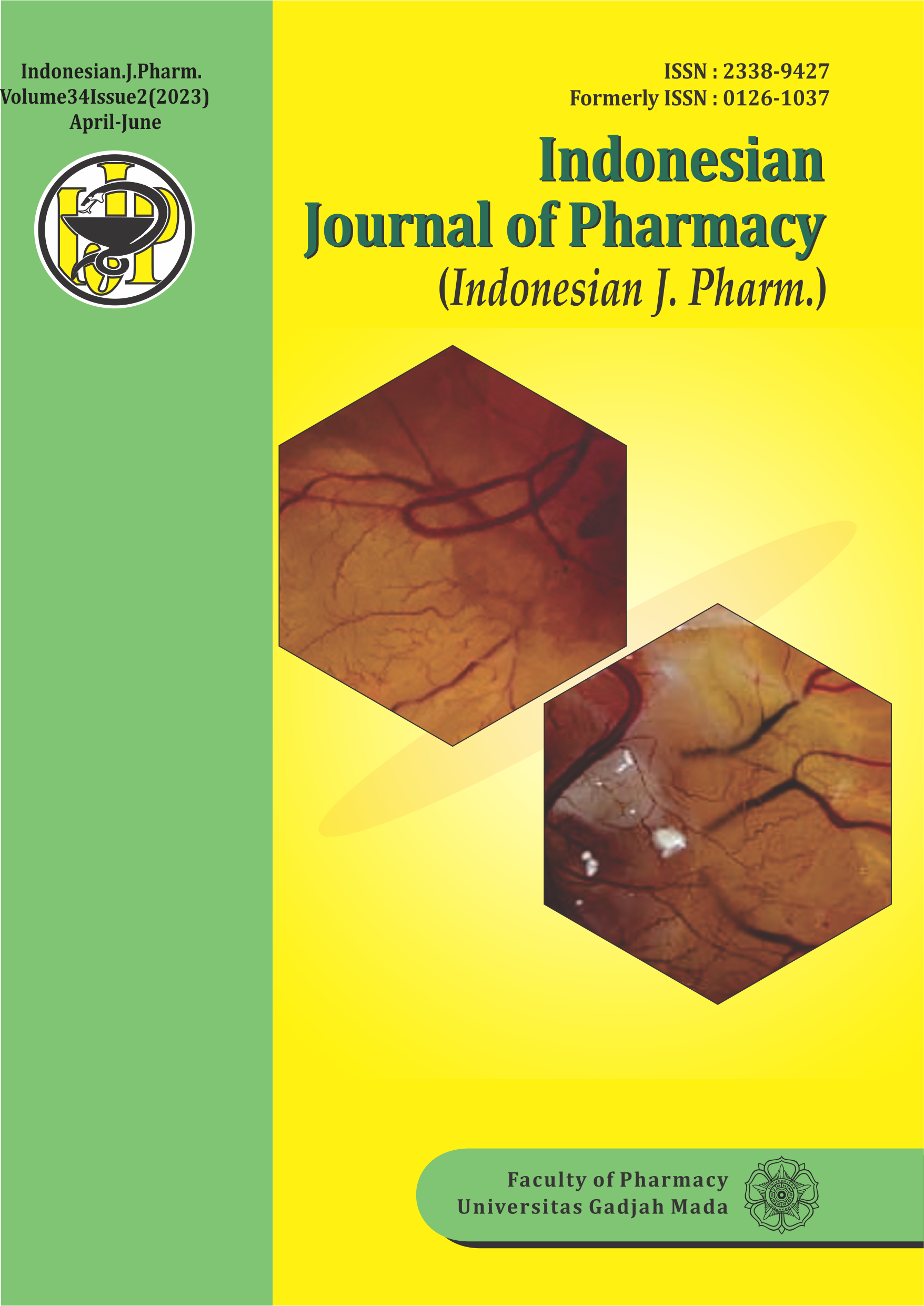Validation of UV-Vis Spectrophotometric Method to Determine Drug Release of Quercetin Loaded-Nanoemulsion
Abstract
A simple validated UV/Vis spectrophotometric method to analyze quercetin released from the nanoemulsion matrix has been developed to study the drug release profile of quercetin loaded-nanoemulsion. Quercetin analysis was carried out at a maximum wavelength of 254 nm. The method showed linearity with a correlation coefficient (r) value of 0.9998 in the range of 4 - 12 μg/mL. The results also demonstrated that the procedure is accurate and precise, with recovery (%) in the range of 99.65 - 100.1312 % and RSD (%) as ≤ 2%. The limit of detection (LOD) and limit of quantitation (LOQ) values were found to be 4.0535 μg/mL and 13.5118 μg/mL, respectively. The developed method was found to be valid to analyze quercetin released in nanoemulsion preparations.
References
Anand David, A. V., Arulmoli, R., & Parasuraman, S. (2016). Overviews of biological importance of quercetin: A bioactive flavonoid. Pharmacognosy Reviews, 10(20), 84–89. https://doi.org/10.4103/0973-7847.194044
Batiha, G. E., Beshbishy, A. M., & Taha, A. (2020). Polyphenolic Flavonoid : Quercetin. March.
Cai, X., Fang, Z., Dou, J., Yu, A., & Zhai, G. (2013). Bioavailability of Quercetin: Problems and Promises. Current Medicinal Chemistry, 20, 2572–2582.
Changediya, V. V, Jani, R., & Kakde, P. (2019). A Review on Nanoemulsions: A Recent Drug Delivery Tool. Journal of Drug Delivery and Therapeutics, 9(5), 185–191. https://doi.org/10.22270/jddt.v9i5.3577
Gao, L., Liu, G., Wang, X., Liu, F., Xu, Y., & Ma, J. (2011). Preparation of a chemically stable quercetin formulation using nanosuspension technology. International Journal of Pharmaceutics, 404(1–2), 231–237. https://doi.org/10.1016/j.ijpharm.2010.11.009
Hua, S. (2014). Comparison of in vitro dialysis release methods of loperamide-encapsulated liposomal gel for topical drug delivery. International Journal of Nanomedicine, 9(1), 735–744. https://doi.org/10.2147/IJN.S55805
Madiha, S., Batool, Z., Tabassum, S., Liaquat, L., Sadir, S., Shahzad, S., Naqvi, F., Saleem, S., Yousuf, S., Nawaz, A., Ahmad, S., Sajid, I., Afzal, A., & Haider, S. (2021). Quercetin exhibits potent antioxidant activity, restores motor and non-motor deficits induced by rotenone toxicity. PLoS ONE, 16(11 November), 1–26. https://doi.org/10.1371/journal.pone.0258928
Nguyen, L. T., Lee, Y. H., Sharma, A. R., Park, J. B., Jagga, S., Sharma, G., Lee, S. S., & Nam, J. S. (2017). Quercetin induces apoptosis and cell cycle arrest in triple-negative breast cancer cells through modulation of Foxo3a activity. Korean Journal of Physiology and Pharmacology, 21(2), 205–213. https://doi.org/10.4196/kjpp.2017.21.2.205
Pangeni, R., Kang, S. W., Oak, M., Park, E. Y., & Park, J. W. (2017). Oral delivery of quercetin in oil-in-water nanoemulsion: In vitro characterization and in vivo anti-obesity efficacy in mice. Journal of Functional Foods, 38, 571–581. https://doi.org/10.1016/j.jff.2017.09.059
Priprem, A., Watanatorn, J., Sutthiparinyanont, S., Phachonpai, W., & Muchimapura, S. (2008). Anxiety and cognitive effects of quercetin liposomes in rats. Nanomedicine: Nanotechnology, Biology, and Medicine, 4(1), 70–78. https://doi.org/10.1016/j.nano.2007.12.001
Ranganathan, S., Halagowder, D., & Sivasithambaram, N. D. (2015). Quercetin suppresses twist to induce apoptosis in MCF-7 breast cancer cells. PLoS ONE, 10(10), 1–21. https://doi.org/10.1371/journal.pone.0141370
Spagnuolo, C., Cerella, C., Russo, M., Chateauvieux, S., Diederich, M., & Russo, G. L. (2011). Quercetin downregulates Mcl-1 by acting on mRNA stability and protein degradation. British Journal of Cancer, 105(2), 221–230. https://doi.org/10.1038/bjc.2011.229
Tang, S. M., Deng, X. T., Zhou, J., Li, Q. P., Ge, X. X., & Miao, L. (2020). Pharmacological basis and new insights of quercetin action in respect to its anti-cancer effects. Biomedicine and Pharmacotherapy, 121(July 2019), 109604. https://doi.org/10.1016/j.biopha.2019.109604
Xu, D., Hu, M. J., Wang, Y. Q., & Cui, Y. L. (2019). Antioxidant activities of quercetin and its complexes for medicinal application. Molecules, 24(6). https://doi.org/10.3390/molecules24061123
Yang, D., Wang, T., Long, M., & Li, P. (2020). Quercetin: Its Main Pharmacological Activity and Potential Application in Clinical Medicine. Oxidative Medicine and Cellular Longevity, 2020. https://doi.org/10.1155/2020/8825387
Yunita, E., Yulianto, D., Fatimah, S., & Firanita, T. (2020). Validation of UV-Vis Spectrophotometric Method of Quercetin in Ethanol Extract of Tamarind Leaf. Journal of Fundamental and Applied Pharmaceutical Science, 1(1). https://doi.org/10.18196/jfaps.010102








